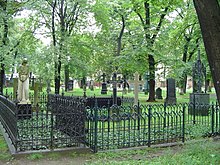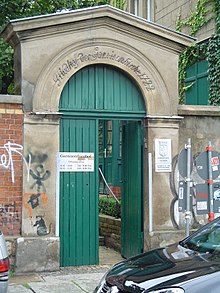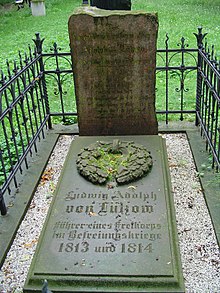Old garrison cemetery
The Old Garrison Cemetery is a listed former cemetery in Berlin district of Mitte . It is located near the Rosenthaler Platz underground station on Kleine Rosenthaler Straße, at the corner of Linienstraße , and houses several tombs, mainly from the 19th century, which are worth preserving, including the graves of some famous personalities, especially those from Prussian military history.
history
The old garrison cemetery is one of the oldest surviving burial sites in Berlin. It was founded around 1706, although the exact times have not been passed down. At that time, the Protestant garrison community of Berlin , founded in 1655, was given a plot of land on the outskirts of the city, between the Rosenthaler and Schönhauser Tor, for the burial of their dead on the instructions of King Friedrich I. This plot of land was much larger than the cemetery that is preserved today, as it also included the area east of today's Gormannstrasse. This eastern part, which had been built on for a long time, was intended for the burial of soldiers , while the western part on Kleine Rosenthaler Strasse was primarily used as a burial place for officers of the Prussian-German army. Also at the beginning of the 18th century, the church of the garrison parish was built near the cemetery. It was rebuilt in 1722 after being destroyed in an explosion in the Berlin Powder Tower ; the number 1722 on the entrance portal of the garrison cemetery still indicates the year of its inauguration.
Initially, the burial places in both parts of the churchyard were reserved for the regiments quartered in the city center . It was not until 1804 that the deceased of all regiments stationed in Berlin were buried here. The two parts of the cemetery differed in their size as well as in their furnishings; the larger military cemetery, known at the time as the common cemetery , was only enclosed by a wooden fence and consisted mainly of uniform row graves, while the western part, known as the officers' cemetery, was surrounded by a solid wall from the start and almost exclusively housed hereditary burials . The administration building from the 19th century, which has been preserved to this day, was built on the site of the officers cemetery.
After the Prussian Land Law was enacted in 1794, the Berlin police administration tried to relocate the two parts of the cemetery from their previous location to the outskirts. The responsible military administration was accused of neglecting the cemeteries, especially the soldier section. As a result, the military administration carried out renovation measures for the cemeteries: the fence of the military cemetery was replaced and new lawns and a well were created. The closure and relocation plans were then stopped, although not finally discarded. The maintenance measures taken and the fact that the new Prussian land law forbade crypt burials in churches, upgraded the garrison cemetery from the beginning of the 19th century, because from then on, even the highest-ranking military personnel could be buried there, more precisely on the officers' section. The cemetery, which previously had a rather shadowy existence, developed into an elegant burial site. Most of the tombs that have survived to this day date from the first half of the 19th century.
In 1854 the War Ministry ordered that the deceased from the garrison hospital should no longer be buried in the old garrison cemetery but in the invalids cemetery. In addition, two new military cemeteries were built in the following years in the outskirts of Berlin, including the 1861 New Garnisonsfriedhof in the Hasenheide and another cemetery in Wedding . The now unneeded, increasingly full community cemetery east of Gormannstrasse was closed to burials in 1867 and converted into a park ten years later, while the officers cemetery continued to accept the deceased. The former military cemetery existed until 1900, when the garrison community sold the area from which some of the deceased had previously been reburied to the officers cemetery . In the following years the area was completely built on. During construction work to close vacant lots caused by war damage, various remains of the deceased were recovered by archaeologists from 2004. The bones of around 300 dead were buried in the garrison grave in the south-west cemetery in Stahnsdorf at the end of 2008 .
While all cemeteries in downtown Berlin were closed for burials until the beginning of the 20th century and some were relocated to the outskirts, the officers cemetery on Kleine Rosenthaler Strasse continued to exist due to the efforts of the military governor. Burials were carried out here regularly until 1945. During the Second World War , the officers cemetery was also used for burials of war dead, sometimes in mass graves . The cemetery was not closed until April 30, 1951, and burials were still allowed in existing family graves. The final burial in the garrison cemetery took place in 1961. As early as the early 1950s, several gravestones and crosses, some of which were worth preserving, were cleared away. In addition, the remains of the garrison church destroyed in the war were removed; this has not been rebuilt to this day.
After the last burial, the previously militarily administered garrison cemetery became the responsibility of the East Berlin magistrate . As the former cemetery became increasingly neglected over time, it was considered to be completely closed at the end of the 1970s. Due to the numerous historically valuable grave structures, it was decided, on the insistence of the Institute for the Preservation of Monuments and the Cultural Association of the GDR, to keep the cemetery as a public park. The subsequent redesign of the former burial site spared only 180 of the original 489 tombs, and the graves of several well-known people were leveled. The original road network was also completely dismantled and most of the grave fields were replaced by lawns. The facility has been a listed building since its redesign .
After reunification , the management of the cemetery was transferred to the Nature Conservation and Green Space Office of the Mitte district . Numerous initiatives for the preservation and care of the facility also emerged, including the Friends of the Alter Berliner Garnisonfriedhof eV
Monuments worth seeing
While not a single grave from the founding time of the garrison cemetery has been preserved, several dozen graves from the 19th and early 20th centuries can be seen in the cemetery, which are important monuments of their time.

Particularly noticeable and characteristic of the garrison cemetery is the large number of cast iron crosses, which mainly date from the first half of the 19th century and testify to the high technical and artistic standards of the Berlin iron art casting of the time. The thin fluidity of the cast alloy based on lawn iron stone made possible fine details and clear lettering that are still legible today. A total of around 20 crosses are made of cast iron in the garrison cemetery, but also some other grave structures, such as the stele on Ludwig von Brauchitsch's grave with a Victoria figure or the neo-Gothic tabernacle from the grave of officer Daniel Friedrich Gottlob Teichert .
In addition, the cemetery houses a number of striking examples of sepulchral architecture from the Romantic , Neo-Gothic and Art Nouveau periods . Well-known artists have also left their mark on the churchyard. Particularly noteworthy is Karl Friedrich Schinkel , who designed the tomb for Lieutenant General Carl Friedrich von Holtzendorff, a red granite stele with a flat gable top and a bronze relief . The design of the Teichert tomb made by Ludwig Wilhelm Wichmann and mentioned above is also attributed to Schinkel. One of the most famous graves here is the Lützow grave, which is still surrounded by a grave grille - most of the old grids were removed in the course of the redesign. The Tippelskirch tomb designed by August Soller is the only cast zinc tomb in the garrison cemetery. An example of Art Nouveau is the life-size mourning figure on the Malcomess grave.
Graves of famous people

Many well-known names from German military history can be found among the numerous high-ranking military men who were buried in the old garrison cemetery in the 19th century. Some prominent personalities from culture and science are also buried here. The most famous people who have found their final resting place in the garrison cemetery include the following:
- Franz Heinrich von Barfuß (1740–1796) Major (oldest preserved grave)
- Heinrich Friedrich Philipp von Bockelberg (1802–1857), Prussian diplomat
- Albert von Boguslawski (1834–1905), General
- Carl Andreas von Boguslawski (1758–1817), General
- Ludwig von Borstell (1773–1844), General (grave not preserved)
- Ludwig Matthias Nathanael Gottlieb von Brauchitsch (1757–1827), governor of Berlin
- Wilhelm von Braun (1883–1941), resistance fighter (grave not preserved)
- Johann Georg Emil von Brause (1774–1836), Major General (grave not preserved)
- Peter of Colomb (1775-1854), General
- Emil Frommel (1828–1896), theologian and writer
- Levin von Geusau (1734–1808), Lieutenant General and Chief of the General Staff of the Prussian Army
- Carl Friedrich Ludwig von Gontard (1764–1839), Lieutenant Colonel (grave not preserved)
- Karl Friedrich von Holtzendorff (1764–1828), General
- Karl Friedrich von dem Knesebeck (1768–1848), Field Marshal General
- Eduard von Kehler (1843–1910), Lieutenant General
- Wilhelm von Krauseneck (1774–1850), Field Marshal General (grave not preserved)
- Otto August Rühle von Lilienstern (1780–1847), Lieutenant General (grave not preserved)
- Karl Georg von Loebell (1777–1841), Lieutenant General
- Ludwig Adolf Wilhelm von Lützow (1782–1834), General
- Friedrich de la Motte Fouqué (1777–1843), major, poet
- August Wilhelm von Neumann-Cosel (1786–1865), general and head of the military cabinet
- Karl Ludwig von Oppeln-Bronikowski (1766–1842), General
- Ferdinand von Stülpnagel (1842–1912), General
- Daniel Friedrich Gottlob Teichert (1796–1853), lieutenant colonel, member of the Frankfurt National Assembly 1848/1849
- Ernst Ludwig von Tippelskirch (1774–1840), Lieutenant General
- Julius von Voss (1768–1832), writer
- Ernestine von Wildenbruch (1805-1858), Salonnière , mother of the writer Ernst von Wildenbruch (grave not preserved)
- Heinrich Emin von Wildenbruch (1842–1893), Colonel in the General Staff and diplomat
- Ludwig von Wildenbruch (1846–1930), Lieutenant General
- Emilie von Willisen (1804–1849), wife of General Karl Wilhelm von Willisen
- Gustav Adolf von Ziegler (1808–1882), Major General and Freemason Order Master
See also
literature
- Gisela Berg, Heinz Berg, Beatrice Falk: The Old Berlin Garrison Cemetery - In the field of tension between Scheunenviertel and Monbijou . Haude & Spener Verlag, Berlin 1995, ISBN 3-77590-399-2
- Klaus Hammer: Cemeteries in Berlin - An art and cultural history guide . Jaron Verlag, Berlin 2006, ISBN 3-89773-132-0
- Hans J. Mende, Dieter Weigert (Ed.): Old Berlin Garrison Cemetery . Luisenstädtischer Bildungsverein, Berlin 2004, ISBN 3-89542-126-X
Web links
- Entry in the Berlin State Monument List
- Old garrison cemetery Berlin
- Friends of the Old Berlin Garrison Cemetery eV
- Official description on berlin.de
- Old garrison cemetery on luise-berlin.de
- Honorary graves of the State of Berlin (PDF; 455 kB)
Individual evidence
- ↑ Thomas Marin: 300 dead reburied , in: Märkische Allgemeine , January 16, 2009, p. 20
- ^ Photo of the grave of Franz Heinrich von Barfuß (accessed on March 13, 2013)
Coordinates: 52 ° 31 ′ 42 ″ N , 13 ° 24 ′ 15 ″ E



